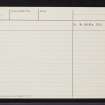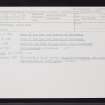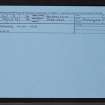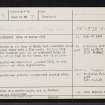Peterhead, Keith Inch, Castle
Castle (Medieval)
Site Name Peterhead, Keith Inch, Castle
Classification Castle (Medieval)
Alternative Name(s) Keith Insch Castle; Ness Of Keith Inch
Canmore ID 21188
Site Number NK14NW 15
NGR NK 1378 4576
Datum OSGB36 - NGR
Permalink http://canmore.org.uk/site/21188
- Council Aberdeenshire
- Parish Peterhead
- Former Region Grampian
- Former District Banff And Buchan
- Former County Aberdeenshire
NK14NW 15 1378 4576.
(NK 1378 4576) Site of Castle (NAT)
OS 6" map, (1929).
The Castle on the Ness of Keith Inch consisted chiefly of a round tower with a flat roof. Joining this tower on the landward side was an unadorned house of two floors, not so high as the tower, and of no great length.
The castle was demolished, around 1813, to make way for harbour and other improvements.
J T Findlay 1933.
The castle was probably constructed shortly after 1589.
J Ferguson 1914.
No trace of a castle exists and no further information was discovered.
Visited by OS (EGC) 28 November 1962.
No change.
Visited by OS (RL) 17 December 1968.
Publication Account (1982)
The two so-called castles of Peterhead were in fact town houses. Both were erected by the Earls Marischal and their ruins in the early nineteenth century were still to be seen in Peterhead' (Arbuthnot, 1815, 80). The oldest of the two castles, according to a well-founded tradition, was situated at the north end of Longate on ground later occupied by a fish curing yard (Findlay, 1933, 70). The second 'castle' was built around 1591 on Keith Inch. It was a two-storey L-shaped residence allegedly modelled on one belonging to the King of Denmark (Neish, 1950, 64). In the eighteenth century the town house did duty as a storehouse, fish-house, granary and subsequently for the storage of powder and shot (Neish 1950, 64; Arbuthnot, 1815, 80) In 1812 the structure was largely removed to make way for the harbour and other improvements and the sale of its slate, stone and wood realised almost i58 (Neish 1950, 64).
Information from ‘Historic Peterhead: The Archaeological Implications of Development’ (1982).














